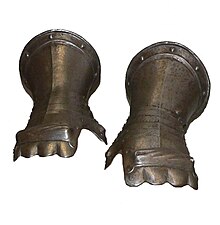Gauntlet (glove)
This article needs additional citations for verification. (February 2023) |


A gauntlet is a type of glove that protects the hand and wrist of a combatant. Gauntlets were used particularly in Europe between the early fourteenth century and the early modern period and were often constructed of hardened leather or metal plates.
Gauntlets, which cover the hands, wrists, and sometimes forearms, are not to be confused with bracers, which cover the wrists and forearms but not the hands; bracers are common in medieval and fantasy cosplay.
Types
Armour

Beginning in the 11th century, European soldiers and knights relied on
A variety of gauntlet called a "demi-gauntlet" or "demi-gaunt" also came into use around this time. A demi-gaunt is a type of plate armour gauntlet that only protects the back of the hand and the wrist: demi-gaunts are worn with gloves made from chain mail or padded leather. The advantages of the demi-gaunt are that it allows better dexterity and is lighter than a full gauntlet, but the disadvantage is that the fingers are not as well protected.
In a 2021-2022 a well-preserved and nearly-intact
Contemporary protective gauntlets


Modern protective gloves called "gauntlets" continue to be worn by metal workers and welders when handling hot or molten metals or in contexts where sparks are common. These gauntlets no longer sport the metal plates of the originals, but instead are highly insulating against heat. Similar varieties of gauntlet are worn by automotive technicians to protect their hands when handling car components, and meat and fishery butchers often wear chain mail gauntlets to protect their hands from the sharp edges of knives. Motorcyclists wear gauntlets made of leather to protect their hands from abrasion during an accident, and snowmobile drivers wear fingerless gauntlets made of nylon to protect their hands from wind and cold temperatures while driving their vehicles. Falconers wear leather gauntlets to protect their hands from the sharp claws of the birds of prey that they handle, and lastly, modern competitors in fencing, particularly those competing with the épée, routinely wear fingered gauntlets to protect their hands from possible cuts and puncture wounds from their opponents' weapons.
As clothing

In Western women's fashion, a gauntlet can refer to an extended cuff with little or no hand covering. Such gauntlets are sometimes worn as elements of an evening gown or by brides at weddings.[3]
Religious
In the Roman Catholic Church, the full-fingered gloves traditionally worn by the pope or other
"Throwing down the gauntlet"
The practice of throwing a gauntlet in response to a challenge has its origins in antiquity. In Book 5 of the Aeneid, Entelus responds to the challenge of the boxer Dares by throwing his caestus (boxing glove, or gauntlet) into the boxing ring.
To "throw down the gauntlet" is to issue a challenge. A gauntlet-wearing knight would challenge a fellow knight or enemy to a duel by throwing one of his gauntlets on the ground. The opponent would pick up the gauntlet to accept the challenge. The phrase is associated particularly with the action of the King's Champion, which officer's role was from medieval times to act as champion for the King at his coronation, in the unlikely event that someone challenged the new King's title to the throne.
References
- ISBN 978-1-84797-515-7.
- ISSN 0362-4331. Retrieved 2024-01-31.
- ^ Wedding Planning: Wedding Accessories - Gloves|Brides.com Archived 2007-10-21 at the Wayback Machine Gauntlet Glove
External links
![]() Media related to Gauntlets at Wikimedia Commons
Media related to Gauntlets at Wikimedia Commons



